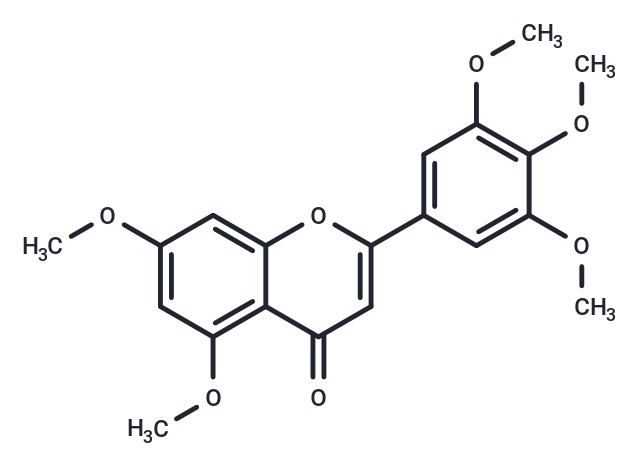Shopping Cart
- Remove All

Your shopping cart is currently empty


| Pack Size | Price | Availability | Quantity |
|---|---|---|---|
| 1 mg | $70 | In Stock | |
| 5 mg | $172 | In Stock | |
| 10 mg | $297 | In Stock | |
| 25 mg | $492 | In Stock | |
| 50 mg | $718 | In Stock | |
| 100 mg | $987 | In Stock | |
| 1 mL x 10 mM (in DMSO) | $193 | In Stock |
| Description | 3',4',5',5,7-Pentamethoxyflavone is a naturally occurring brassinosteroid compound from the Rutaceae family that exhibits resistance to cancer cells by inhibiting the Nrf2 pathway to overcome chemotherapeutically active molecules. |
| In vitro | 3',4',5',5,7-Pentamethoxyflavone (PMF), a natural flavonoid extracted from Rutaceae plants, sensitized A549/CDDP to CDDP and substantially induced apoptosis compared with that of CDDP alone treated group, and this reversal effect decreased when Nrf2 was downregulated by siRNA. Mechanistically, PMF reduced Nrf2 expression leading to a reduction of Nrf2 downstream genes, and in contrast, this effect was decreased by blocking Nrf2 with siRNA. Taken together, these results demonstrated that PMF could be used as an effective adjuvant sensitizer to increase the efficacy of chemotherapeutic drugs by downregulating Nrf2 signaling pathway.[1] |
| In vivo | The flavones tricin (4',5,7-trihydroxy-3',5'-dimethoxyflavone) and 3',4',5',5,7-Pentamethoxyflavone (PMF) are under development as potential colorectal cancer chemopreventive agents as they reduced adenoma development in the Apc(Min) mouse model of intestinal carcinogenesis. Plasma concentrations and area under the plasma concentration versus time curve for PMF were higher than those for tricin. A mono-O-desmethyl PMF and several isomeric mono-O-desmethyl PMF glucuronides and sulfonates were major PMF metabolites in murine plasma, liver and intestinal tissue. In murine and human liver fractions, in vitro metabolic removal of tricin was faster than that of PMF[1]. |
| Alias | 5,7,3',4',5'-Pentamethoxyflavone |
| Molecular Weight | 372.37 |
| Formula | C20H20O7 |
| Cas No. | 53350-26-8 |
| Storage | store at low temperature|Powder: -20°C for 3 years | In solvent: -80°C for 1 year | ||||||||||||||||||||||||||||||
| Solubility Information | DMSO: 22.5 mg/mL (60.4 mM), Sonication is recommended. | ||||||||||||||||||||||||||||||
Solution Preparation Table | |||||||||||||||||||||||||||||||
DMSO
| |||||||||||||||||||||||||||||||

Copyright © 2015-2024 TargetMol Chemicals Inc. All Rights Reserved.